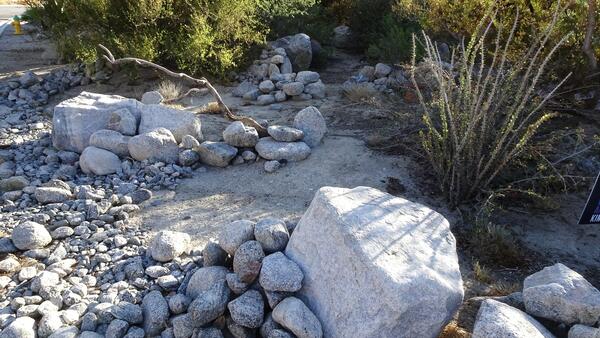Wildlife gardening as a naturalist
“To a naturalist nothing is indifferent; the humble moss that creeps upon the stone is equally interesting as the lofty pine which so beautifully adorns the valley or the mountain.” — James Hutton
Being a naturalist opens our eyes to the world beyond the infrastructure of human constructs. No hike in nature is dull; every excursion there is both an anticipation and fulfillment for meeting something new, of learning of new connections in the web of life.
There is, however, a dark side. Being a naturalist, and its attendant passion for nature, can make every trash heap, every new bulldozer scar on a hillside, every track of a motorcycle or dune buggy across a sand dune, every drought-shriveled plant, seem as though a personal affront, a loss that is felt more deeply. Those deep dark feelings can spawn action, action that can occur at multiple scales, from vast landscapes to our own backyards.
Each of us lives in a house that occupies a space that was previously the territory of a lizard family, a ground squirrel, a bird, and a multitude of beetles, bees, butterflies, and spiders. All were pushed aside to build our homes. Adding to this insult to nature we too often plant lawns and an assortment of trees and shrubs that belong in some other corner of our planet, creating a sterile placard announcing our lack of connection to, and lack of concern for, nature. Or we can eschew the lawn and plant a rich assortment of plants that evolved locally where we now live, pile boulders and rocks to create nooks and crannies of safe havens, welcoming back those that our home displaced. Having a house, our personal sanctuary, is more than important, it is essential for our safety and wellbeing. But we can have those comforts and still provide an inviting home for nature. Another consideration is that as the current trend toward both hotter and drier conditions continues, creating a refugium for wildlife around your home may allow some native wildlife species enough habitat to persist while their brethren occupying lower elevations of the surrounding desert may not.
How to start? One beginning is to go out in nature and look for plants and rocks, their arrangement and spacing, that are particularly pleasing to your eye. Then, imagine that combination within the confines of your yard. Start with one or three (it turns out odd numbers are more attractive to our brains than even numbers) focal plants – better if they will become large trees to provide cooling shade. In our desert, desert willows are an excellent choice, as are paloverdes, honey mesquite, or ironwoods. Each can get large, provide a lot of shade, and will sequester carbon dioxide, transferring it deep into their roots where it will do no harm to our climate. Of those choices, desert willows are the only species on that list that are thornless and winter deciduous, providing summer shade and then allowing in the warming sun in the winter. Next pick some accent shrubs, perhaps jojoba, brittlebush, chuparosa or desert milkweed. Then add shorter-lived flowering species such as penstemons and desert marigolds. If children or pets are not an issue, barrel cacti offer extremely interesting additions. Then add boulders and rocks, but not one or two, create “family groups” of large and small, again odd numbers are best, and layer them in a way that create lizard hiding spots. Unlike plants, with some effort you can move rocks around as your tastes change, like changing the arrangement of art hanging on your walls. Also, unlike plants, rocks and boulders do not require water, but they do act as an effective mulch, reducing evaporation of water from the soil surface, keeping more water in the soil to be accessed by nearby plant roots.
There is a name for this sort of landscaping, it’s called “wildlife gardening.” The goal is to not only make an aesthetically pleasing yard, but it is also to create a haven for wildlife. Desert willow and chuparosa flowers will feed hummingbirds through much of the year. Milkweed and brittlebush will nourish butterflies and bees. Paloverde, mesquite, and ironwood are critical “fueling stations” for migrating songbirds in March and April – coincident with when these trees are in flower and attract insects. Shade from the trees will keep summer temperatures closer to tolerable. Rock piles seem to spawn lizards who use the crevices to escape those pesky roadrunners that otherwise thrive in suburban yards. Birds are what are left of the dinosaur lineage, and roadrunners are, to me, a close analogue to a velociraptor. Velociraptors are likely one of the direct ancestors of modern birds. Not the Jurassic Park velociraptor, but the true velociraptors which were about the size of a turkey, had feathers, but not for flying, and were adept predators of Mesozoic lizards. Roadrunners, along with mockingbirds, house finches, and mourning doves, are native desert birds that have embraced human-generated landscapes and as a result, thrived. In the nearly four decades I have lived in the desert, I can count the number of roadrunners I have seen more than a mile from suburbia on one hand. They are adaptable, smart, and voracious predators. Without rock piles, lizards do not have a chance. Add a couple water basins to your native desert landscaping and wildlife will appear; build it and they will come.
As much as the birds, bees, butterflies, and lizards will enjoy it, there is an equally important benefit. Your peace of mind. The dark feelings we can get about the erosion of nature in the name of human progress can be set aside for a while through this relatively simple act of creation. The connection to nature is as important to our well-being as it is to the animals and plants.
Nullius in verba
Go outside, tip your hat to a chuckwalla (and a cactus), think like a mountain, and be safe.
